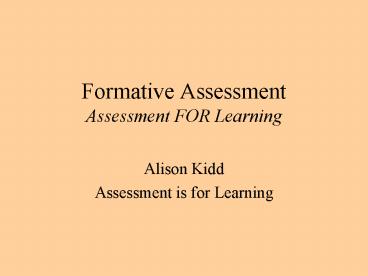Formative Assessment Assessment FOR Learning - PowerPoint PPT Presentation
1 / 22
Title:
Formative Assessment Assessment FOR Learning
Description:
Staff will know the 4 key ideas which can help us to ... (Pose, pause, pounce, bounce) Active Assessment. Effects of. Increased Wait Time. Longer answers ... – PowerPoint PPT presentation
Number of Views:328
Avg rating:3.0/5.0
Title: Formative Assessment Assessment FOR Learning
1
Formative AssessmentAssessment FOR Learning
- Alison Kidd
- Assessment is for Learning
2
Learning Intention Success Criteria
- We are learning about developments in formative
assessment and their impact on learning and
teaching
- Staff will know the 4 key ideas which can help us
to improve learning, achievement and attainment - Staff will know several strategies which they can
apply in their own context.
3
The 4 key ideas
- Sharing learning intentions, discuss success
criteria
- Effective feedback
- Effective questioning and quality discussion
- Peer/self evaluation
4
Learners learn best if they
- Understand clearly what they are trying to learn
and what is expected of them - Are given feedback on their work and advice on
what they need to do to improve - They are fully involved in deciding what needs to
be done next and who can give them help if they
need it
5
Key Question
- What does effective classroom dialogue
- look like and sound like?
6
Effective dialogue
- Pupils and teachers get the feedback they need to
move the learning forward - Learning starts from where the pupils are
- Pupils are active in the process of learning
- Teacher/pupil learns what the pupil knows, partly
knows and doesnt know.
7
Rich questions
- Questions to explore pupil understanding of
Learning Intention - Planning key questions- collaborate
- Use Blooms taxonomy
- Children asking questions
- Thinking hats
8
Changing the thinking demand of Qs
- Thinking Demand Blooms Taxonomy
High
Evaluating( making judgements)
Synthesis (creating something new)
Analysis ( breaking things down)
Thinking demand
Application (apply to new contexts/situations)
Comprehension (simple explanation)
Low
Knowledge (recall)
Blooms Taxonomy ( Different ways of thinking )
9
More questioning strategies
- A range of answers
- A statement
- Right and wrong
- Giving the answer
- (Shirley ClarkeFormative assessment in action)
10
A range of answers...
- Which activities improve the efficiency of the
heart?
- Cycling
- Walking
- Golf
- Swimming
- Skydiving
- Darts
11
A Statement
- All drugs are bad for you.
- All metals are magnetic
- Goldilocks was a burglar
- Everyone Jesus met was pleased to see him.
- Agree or disagree and give reasons
- Agree or disagree and give reasons
12
Right and wrong/opposites
- Why is this sum right and this sum wrong?
- Why is this sentence grammatically correct and
this one not?
- Why does this ball bounce and this one doesnt?
- (Beat the teacher!)
13
Giving the answer
- Paper is a good material for tissues-why?
- This is a complex sentence-why?
- 73212. What strategies did you use to come up
with the answer?
14
Spot the difference
- What makes the dialogue in transcript 2 more
effective than that in transcript 1?
15
Strategies to support all learners
- Wait time
- Think, pair, share
- No hands up
- Basketball or table tennis?
- (Pose, pause, pounce, bounce)
- Active Assessment
16
Effects of Increased Wait Time
- Longer answers
- Decreased failure of response
- Increased confidence of response
- Students challenged and/or improved answers of
other students - More alternative explanations offered
17
Effective Feedback
- Poster parade/comfort break!
18
- Effective Feedback
- The rule of thumb is to
- keep your corrections and your comments specific
and ensure that they put responsibility back onto
the pupil. - The pupil should spend more time responding to
the marking than you spend doing it.
19
Feedback needs
- To focus on clear learning intentions/success
criteria - To highlight where success occurred and where
improvement could take place - To be in a form which is accessible to the
learner - To give strategies for improvement (often oral),
if this is beyond the means of the learner - Allocated time in which to take place
- To be used by teachers to plan future learning
- Systematically relinquish control, modelling
processes
20
Improvement prompts
- Reminder prompt Say more about Pauls character.
- Scaffolded prompt What type of boy is Paul -
good, bad, shy, kind? Or your own idea.
Finish this Paul
liked to play jokes on people. For instance,
he - Example prompt Choose one of these or your own to
describe his character
James was a kind, likeable boy with a
great sense of humour.
James was easily bored and liked lots of
attention.
21
3 key points for plenary
- Overall impression of strategies
- One great idea
- One next step
22
Further reading
- Kings College ( Nfer Nelson)
- Inside the Black Box
- Working Inside the Black Box
- Science Inside the Black Box
- Shirley Clarke Hodder and Murray Publications
- Formative Assessment in the Secondary
Classroom(2005) - Enriching Feedback (2003)
- Formative Assessment in action(2005)































